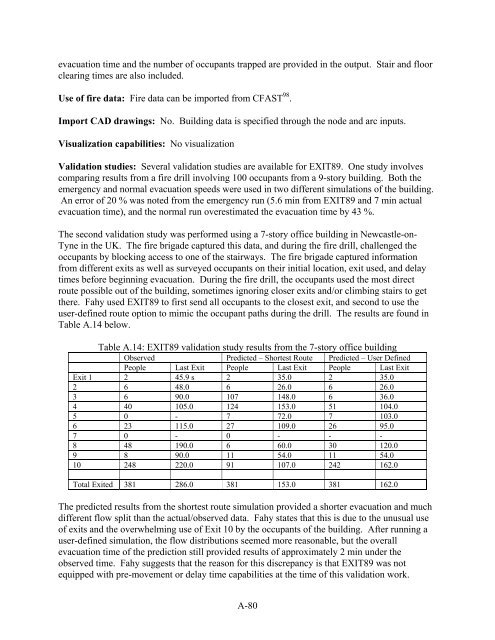A Review of Building Evacuation Models - NIST Virtual Library
A Review of Building Evacuation Models - NIST Virtual Library
A Review of Building Evacuation Models - NIST Virtual Library
You also want an ePaper? Increase the reach of your titles
YUMPU automatically turns print PDFs into web optimized ePapers that Google loves.
evacuation time and the number <strong>of</strong> occupants trapped are provided in the output. Stair and floor<br />
clearing times are also included.<br />
Use <strong>of</strong> fire data: Fire data can be imported from CFAST 98 .<br />
Import CAD drawings: No. <strong>Building</strong> data is specified through the node and arc inputs.<br />
Visualization capabilities: No visualization<br />
Validation studies: Several validation studies are available for EXIT89. One study involves<br />
comparing results from a fire drill involving 100 occupants from a 9-story building. Both the<br />
emergency and normal evacuation speeds were used in two different simulations <strong>of</strong> the building.<br />
An error <strong>of</strong> 20 % was noted from the emergency run (5.6 min from EXIT89 and 7 min actual<br />
evacuation time), and the normal run overestimated the evacuation time by 43 %.<br />
The second validation study was performed using a 7-story <strong>of</strong>fice building in Newcastle-on-<br />
Tyne in the UK. The fire brigade captured this data, and during the fire drill, challenged the<br />
occupants by blocking access to one <strong>of</strong> the stairways. The fire brigade captured information<br />
from different exits as well as surveyed occupants on their initial location, exit used, and delay<br />
times before beginning evacuation. During the fire drill, the occupants used the most direct<br />
route possible out <strong>of</strong> the building, sometimes ignoring closer exits and/or climbing stairs to get<br />
there. Fahy used EXIT89 to first send all occupants to the closest exit, and second to use the<br />
user-defined route option to mimic the occupant paths during the drill. The results are found in<br />
Table A.14 below.<br />
Table A.14: EXIT89 validation study results from the 7-story <strong>of</strong>fice building<br />
Observed Predicted – Shortest Route Predicted – User Defined<br />
People Last Exit People Last Exit People Last Exit<br />
Exit 1 2 45.9 s 2 35.0 2 35.0<br />
2 6 48.0 6 26.0 6 26.0<br />
3 6 90.0 107 148.0 6 36.0<br />
4 40 105.0 124 153.0 51 104.0<br />
5 0 - 7 72.0 7 103.0<br />
6 23 115.0 27 109.0 26 95.0<br />
7 0 - 0 - - -<br />
8 48 190.0 6 60.0 30 120.0<br />
9 8 90.0 11 54.0 11 54.0<br />
10 248 220.0 91 107.0 242 162.0<br />
Total Exited 381 286.0 381 153.0 381 162.0<br />
The predicted results from the shortest route simulation provided a shorter evacuation and much<br />
different flow split than the actual/observed data. Fahy states that this is due to the unusual use<br />
<strong>of</strong> exits and the overwhelming use <strong>of</strong> Exit 10 by the occupants <strong>of</strong> the building. After running a<br />
user-defined simulation, the flow distributions seemed more reasonable, but the overall<br />
evacuation time <strong>of</strong> the prediction still provided results <strong>of</strong> approximately 2 min under the<br />
observed time. Fahy suggests that the reason for this discrepancy is that EXIT89 was not<br />
equipped with pre-movement or delay time capabilities at the time <strong>of</strong> this validation work.<br />
A-80
















